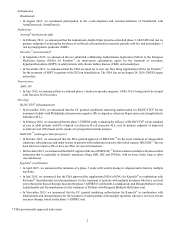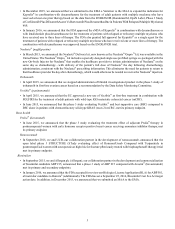Amgen 2015 Annual Report Download - page 19
Download and view the complete annual report
Please find page 19 of the 2015 Amgen annual report below. You can navigate through the pages in the report by either clicking on the pages listed below, or by using the keyword search tool below to find specific information within the annual report.11
We perform various procedures to assist in authenticating the source of raw materials, including intermediary materials
used in the manufacture of our products, which include verification of the country of origin. These procedures are incorporated
into the manufacturing processes we and our third-party contract manufacturers perform.
Government Regulation
Regulation by government authorities in the United States and other countries is a significant factor in the production and
marketing of our products and our ongoing R&D activities. In order to clinically test, manufacture and market products for
therapeutic use, we must satisfy mandatory procedures and safety and effectiveness standards established by various regulatory
bodies. Compliance with these standards is complex and failure to comply with any of these standards can result in significant
implications. See Item 1A. Risk Factors for a discussion of factors that can adversely impact our development and marketing of
commercial products including global regulatory implications.
Regulation in the United States
In the United States, the Public Health Service Act, the Federal Food, Drug, and Cosmetic Act (FDCA) and the regulations
promulgated thereunder, as well as other federal and state statutes and regulations govern, among other things, the production,
research, development, testing, manufacture, quality control, labeling, storage, record keeping, approval, advertising and
promotion, reporting of certain payments and other transfers of value, and distribution of our products.
Clinical Development and Product Approval. Drug development in our industry is complex, challenging and risky; and
failure rates are high. Product development cycles are typically very long - approximately 10 to 15 years from discovery to market.
A potential new medicine must undergo many years of preclinical and clinical testing to establish its safety and efficacy for use
in humans at appropriate dosing levels and with an acceptable risk-benefit profile.
After laboratory analysis and preclinical testing in animals, we file an Investigational New Drug Application (IND) with
the FDA to begin human testing. Typically, we undertake an FDA-designated three-phase human clinical testing program.
• In phase 1, we conduct small clinical trials to investigate the safety and proper dose ranges of our product candidates
in a small number of human subjects.
• In phase 2, we conduct clinical trials to investigate side effect profiles and the efficacy of our product candidates in
a large number of patients who have the disease or condition under study.
• In phase 3, we conduct clinical trials to investigate the safety and efficacy of our product candidates in a large number
of patients who have the disease or condition under study.
The FDA monitors the progress of each trial conducted under an IND and may, at its discretion, re-evaluate, alter, suspend
or terminate the testing based on the data accumulated to that point and the FDA’s risk-benefit assessment with regard to the
patients enrolled in the trial. The results of preclinical and clinical trials are submitted to the FDA in the form of a BLA for biologic
products or an NDA for small molecule products. We cannot market or promote a new product until our marketing application
has been approved by the FDA.
Approval of Biosimilars. The ACA authorized the FDA to approve biosimilars via a separate, abbreviated pathway. The
pathway allows sponsors of a biosimilar to seek and obtain regulatory approval based in part on the non-clinical and clinical trial
data of an originator product to which the biosimilar has been demonstrated to be “similar.” The relevance of demonstrating
“similarity” is that in many cases, biosimilars can be brought to market without conducting the full suite of clinical trials typically
required of originators, as risk-benefit has previously been established. In order to preserve incentives for future innovation, the
law establishes a period of exclusivity for originators’ products, which prohibits biosimilars from gaining FDA approval based in
part on reliance on or reference to the originator’s data in their application to the FDA for 12 years after FDA approval of the
originator product. The law does not change the duration of patents granted on biologic products. The FDA has released seven
guidance documents as part of the implementation of the abbreviated approval pathway for biosimilars and four of these have
been finalized. The FDA has announced its planned publication of additional draft guidance documents relating to biosimilar
interchangeability and biosimilars labeling. As of the end of 2015, one biosimilar application has been approved by the FDA, and
a number of manufacturers have announced the filing of marketing applications to the FDA under the biosimilar pathway, some
of which are for biosimilars of our products.
Regulation of Product Marketing and Promotion. The FDA regulates the marketing and promotion of products. Our product
promotion for approved product indications must comply with the statutory standards of the FDCA, and the FDA’s implementing
regulations and standards. The FDA’s review of marketing and promotional activities encompasses, but is not limited to, direct-
to-consumer advertising, healthcare provider-directed advertising and promotion, sales representative communications to
healthcare professionals, promotional programming and promotional activities involving the Internet. The FDA may also review
industry-sponsored scientific and educational activities that make representations regarding product safety or efficacy in a
























